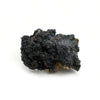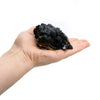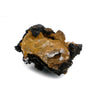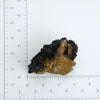See more: Specimens
Pyrolusite Specimen #92
$ 125.00
- Pyrolusite Specimen #92
- Pyrolusite is a mineral consisting essentially of manganese dioxide (MnO2) and is important as an ore of manganese. It is a black, amorphous appearing mineral, often with a granular, fibrous, or columnar structure, sometimes forming reniform crusts. It has a metallic luster, a black or bluish-black streak, and readily soils the fingers. The specific gravity is about 4.8. Its name is from the Greek for fire and to wash, in reference to its use as a way to remove tints from glass.
- Natural Pyrolusite has been used in batteries, but high-quality batteries require synthetic products. Pyrolusite is also used to prepare disinfectants (permanganates) and for decolorizing glass. When mixed with molten glass it oxidizes the ferrous iron to ferric iron, and so discharges the green and brown tints (making it classically useful to glassmakers as a decolorizer). As a coloring material, it is used in calico printing and dyeing; for imparting violet, amber, and black colors to glass, pottery, and bricks; and in the manufacture of green and violet paints.
- Measures approx. 3" x 3" x 2 1/2"
- Some of the most famous early cave paintings in Europe were executed by means of manganese dioxide. Blocks of pyrolusite are found often at Neanderthal sites. It may have been kept as a pigment for cave paintings, but it has also been suggested that it was powdered and mixed with tinder fungus for lighting fires.[9] Manganese dioxide, in the form of umber, was one of the earliest natural substances used by human ancestors. It was used as a pigment at least from the middle paleolithic. It may have been also used by the Neanderthals in fire-making.[10]
- Origin the San Antonio Mine, Santa Eulalia Mining District, Chihuahua, Mexico








